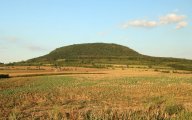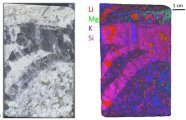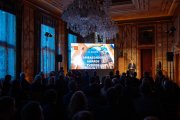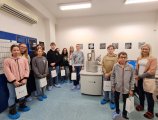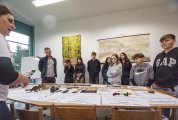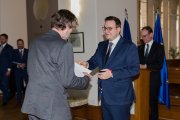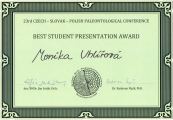News
Latest geological insights into the Říp Hill volcano
Research by Czech geologists od the Institute of Geology CAS, Charles University, Masaryk University and VŠB_Technical University Ostrava revealed that the legendary landmark of Říp Hill is a remnant of a volcanic eruption that occurred over 26 million years ago. This hill, cocated near the zone of significant Tertiary volcanic activity (Ohře Graben), was formed during a subsurface explosion of the so-called maar volcano. The eruption was triggered by the contact of rising magma with groundwater. The sudden conversion of water into steam caused an extreme build-up of pressure, leading to a powerful explosion. A crater was formed on the surface, later filled with lava. This solidified lava lake, spaed by erosion, now forms the main body of the hill. The research was also contributed by two high school students within the Open Science program of the Czech Academy of Sciences.
Institute of Geology participating in the development of new methods
Institute of Geology participating in the development of new methods
Together with the CEITEC VUT team (Brno University of Technology) and other partners, our colleague Tomáš Hrstka participated in the presentation “Towards geological applications utilizing Laser-induced Breakdown Spectroscopy”. Being given at the CEITEC Workshop on Multi-scale Imaging, held on April 1 2025 in Brno, the presentation unveiled the potential of advanced analytical methods of laser spectroscopy (Laser-Induced Breakdown Spectroscopy – LIBS). Specifically, an industrial application for the determination of the amounts of lithium and other critical elements in ores was demonstrated. The method benefits from a wider project developing innovative methods of preparation and analysis of mineralogical/petrological samples for the study of geological processes and environmental monitoring. This research, also supported by the Strategy AV21 – Dynamic planet Earth programme, provides a new look at processes of the origin of rocks and ore deposits and a potential optimization of their nature-friendly processing. The photo shows a sample of a lithium ore together with an LIBS-generated elemental map of the same sample, showing the distribution of lithium and other elements in the ore.
a link for the text CEITEC Workshop on Multi-scale Imaging: here
Nomination of a paleontological congress at the Ambassador Awards Evening
The event called XV International Palynological Congress & XI International Organization of Palaeobotany Conference in Prague, the organization of which was significantly contributed by the Institute of Geology represented by Jiří Bek (Chairman), Jana Votočková Frojdová (Secretary General) and Marcela Svobodová (in the position of the Organizing Committee member), was nominated for an award in the category “Congress of the year 2024 below 500 participants”. The awards were granted at the 14th annual “Ambassador Awards Evening“ – a ceremony held by the Prague Convention Bureau under the auspices of the Capital of Prague and the City Mayor in appreciation of those who have significantly contributed to the development of congress industry in Prague. Although our team missed the award, the nomination still poses a great success arising from extensive work for the scientific community.
Jiří Bek elected Vice-President of international palynological body again
Jiří Bek was elected the Vice-President of the International Federation of Palynological Societes (IFPS), which unites over 3500 members from all over the world. Palaeopalynology and actuopalynology focus on modern and fossil palynomorphs (especially spores and pollen) and significantly contribute to stratigraphy, palaeontology (definition of stratotypes), archaeology, melissopalynology, forensic sciences (police investigation) and research into human allergies in medicine. Jiří Bek is the only palynologist who was elected the IFPS Vice-President for the second time.
A new journey from macro- to micro-world completed
In October 2024, the second event promoting microscopic techniques was held under the guidance of Eva Pecková of the Institute of Geology. The project was coordinated with the Dolákova Basic School in Prague 8. Various biological and mineral samples were presented at this school using their equipment, and complemented with a display of images taken by the Institute of Geology staff within their research. The second part of the event took place at the Institute facility in November, where selected senior students got acquainted with the operation of the Tescan Vega 3XMU electron microscope. They were also presented with the Mohs scale of mineral hardness (Z. Korbelová) and real-time crystallization (J. Rohovec). The project was supported by the Czechoslovak Microscopy Society and the Tescan Company.
An Open Day at the Institute of Geology
An Open Day was held at the Institute of Geology as an event within the Week of the Academy of Sciences on November 6 and 8, 2024. The visitors had the opportunity to visit the mineral separation laboratories, the chemical laboratory and the optical laboratory. The presented geoscientific disciplines included paleonotology and geoarchaeology.
Highlights in international cooperation in Cretaceous studies
Fossils from the chalk cliffs of Stevns Klint in Denmark were described by an international team from the Czech Republic, Denmark, Slovenia and Germany. The cliffs, listed as a UNESCO World Heritage Site, are famous for the presence of the youngest Cretaceous and oldest Paleocene strata including the boundary between these two stratigraphic units. Martina Kočová Veselská of the Institute of Geology AS CR and Tomáš Kočí of the Slovenian Institute for Palaeobiology and Evolution presented the project results at the international conference at Maastricht, the Netherlands, which was held to commemorate the 175th anniversary of the erection of the Maastrichtian stage (the youngest stage of the Cretaceous). The study of the Stevns Klint fossils, which document thriving marine life at the end of the Cretaceous, falls within the research project run by the Geomuseum Faxe and the Strategy AV21 project. The event and the results of the current research attracted the attention of the Danish newspaper Sjællandske Nyheder. Link here
A new Member of the Czech UNESCO Commission
Radek Mikuláš, a researcher of the Institute of Geology, was appointed a Member of the Czech UNESCO Commission by the Minister of Foreign Affairs Jan Lipavský. This Commission (nominated for the 2024–2027 period) functions as an advisory body for the Government, focusing on mutual communication between the Czech institutions and experts and UNESCO. The Commission is also committed to study UNESCO documents, to disseminate UNESCO ideas in the Czech Republic and to submit proposals for further activities to the UNESCO Headquarters in Paris. The Commission also accepts moral aegis for projects directly related to the UNESCO programme. The Commission has established professional sections: (1) for culture and communication, (2) for education, science and informatics, and (3) for the environment. Radek Mikuláš is active in Sections 2 and 3.
Photo by the Ministry of Foreign Affairs of the Czech Republic.
Award for the best student presentation in the Open Science Project
Ema Danielová and Zuzana Hájková received an award for the best student presentation during their scientific internship in the Open Science project of the Czech Academy of Sciences. Under the supervision of Filip Tomek of the Institute of Geology of the Czech Academy of Sciences, they studied mythical significance of volcanoes and their reflection in historical myths and legends. Their research highlighted the everlasting fascination of humans by natural phenomena and their cultural interpretations that have lasted for centuries. Their presentation at the student conference within the Week of the Czech Academy of Sciences was recognized as the best in the field of solid Earth sciences. Congratulations to Ema and Zuzka on their outstanding achievement!
Paleontological Conference and the Award for the best student presentation
The traditional annual meeting of enthusiasts in paleontology was held in Banská Bystrica within the 23rd Czech–Slovak–Polish Paleontological Conference. It was organized by the staff of the Earth Science Institute of the Slovak Academy of Sciences. Scientific results were also presented by ten paleontologists of the Institute of Geology of the Czech Academy of Sciences (download the Book of Abstracts here). The Award for the best student presentation was granted to Monika Uhlířová of the Department of Paleobiology and Paleontology.
News archive
Looking for older news? Visit the news archive (news older than one year).


